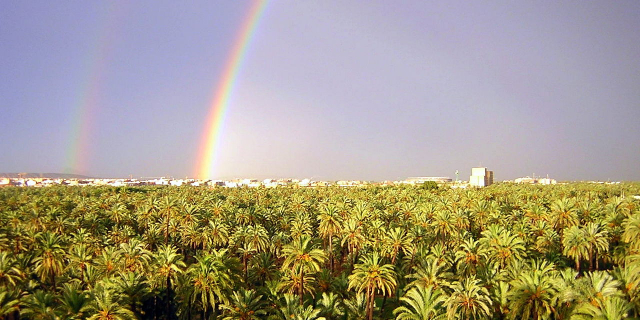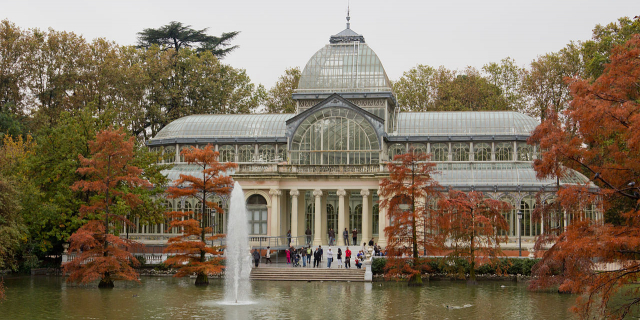País Valencià
Valencian CommunityContext of Valencian Community
The Valencian Community (Valencian: Comunitat Valenciana, Spanish: Comunidad Valenciana) is an autonomous community of Spain. It is the fourth most populous Spanish autonomous community after Andalusia, Catalonia and the Community of Madrid with more than five million inhabitants. Its homonymous capital Valencia is the third largest city and metropolitan area in Spain. It is located along the Mediterranean coast on the east side of the Iberian Peninsula. It borders with Catalonia to the north, Aragon and Castilla–La Mancha to the west, and Murcia to the south, and the Balearic Islands are to its east. The Valencian Community consists of three provinces which are Castellón, Valencia and Alicante.
According to Valencia's Statute of Autonomy, the Valencian people are a nationality. Their origins date back to the 1238 Aragonese conquest of the Taifa of Valencia. The newly-founded Kingdom of Valencia enjoy...Read more
The Valencian Community (Valencian: Comunitat Valenciana, Spanish: Comunidad Valenciana) is an autonomous community of Spain. It is the fourth most populous Spanish autonomous community after Andalusia, Catalonia and the Community of Madrid with more than five million inhabitants. Its homonymous capital Valencia is the third largest city and metropolitan area in Spain. It is located along the Mediterranean coast on the east side of the Iberian Peninsula. It borders with Catalonia to the north, Aragon and Castilla–La Mancha to the west, and Murcia to the south, and the Balearic Islands are to its east. The Valencian Community consists of three provinces which are Castellón, Valencia and Alicante.
According to Valencia's Statute of Autonomy, the Valencian people are a nationality. Their origins date back to the 1238 Aragonese conquest of the Taifa of Valencia. The newly-founded Kingdom of Valencia enjoyed its own legal entity and administrative institutions as a component of the Crown of Aragon, under the purview of the Furs of Valencia. Valencia experienced its Golden Age in the 15th century, as it became the Crown's economic capital. Local institutions and laws continued during the dynastic union of the early modern Spanish Monarchy, but were suspended in 1707 as a result of the Spanish War of Succession. Valencian nationalism emerged towards the end of the 19th century, leading to the modern conception of the Valencian Country. The current autonomous community under the Generalitat Valenciana self-government institution was established in 1982 after the Spanish Transition.
Official languages are Spanish and Valencian (the official and traditional name used in the Valencian Community to refer to what is commonly known as the Catalan language). As of 2020, the population of the Valencian Community comprised 10.63% of the Spanish population.
More about Valencian Community
- Native name País Valencià
- Population 5097967
- Area 23255
 Archeological site of Tossal de Manises, ancient Iberian–Greek–Carthaginian–Roman city of Akra Leuke or Lucentum, Alicante.Villena castle (see Route of the Castles of Vinalopó)
Archeological site of Tossal de Manises, ancient Iberian–Greek–Carthaginian–Roman city of Akra Leuke or Lucentum, Alicante.Villena castle (see Route of the Castles of Vinalopó)The pre-Roman autochthonous people of the Valencian Community were the Iberians, who were divided in several groups (the Contestani, the Edetani, the Ilercavones and the Bastetani).
...Read moreRead less Archeological site of Tossal de Manises, ancient Iberian–Greek–Carthaginian–Roman city of Akra Leuke or Lucentum, Alicante.Villena castle (see Route of the Castles of Vinalopó)
Archeological site of Tossal de Manises, ancient Iberian–Greek–Carthaginian–Roman city of Akra Leuke or Lucentum, Alicante.Villena castle (see Route of the Castles of Vinalopó)The pre-Roman autochthonous people of the Valencian Community were the Iberians, who were divided in several groups (the Contestani, the Edetani, the Ilercavones and the Bastetani).
The Greeks established colonies in the coastal towns of Saguntum and Dianium beginning in the 5th century BC, where they traded and mixed with the local Iberian populations. After the end of the First Punic War between Carthage and Rome in 241 BC, which established their limits of influence in the Ebro river, the Carthaginians occupied the whole region. The dispute over the hegemony of Saguntum, a Hellenized Iberian coastal city with diplomatic contacts with Rome, destroyed by Hannibal in 219 BC, ignited the Second Punic War, which ended with the incorporation of the region to the Roman Empire.
The Romans founded the city of Valentia in 138 BC, which, over the centuries overtook Saguntum in importance. After the Fall of the Western Roman Empire, during the Barbarian Invasions in the 5th century AD, the region was first invaded by the Alans and finally ruled by the Visigoths (see Valencian Gothic), until the arrival of the Arabs in 711, which left a broad impact in the region, still visible in today's Valencian landscape and culture. After the fall of the Caliphate of Cordova, two main independent taifas were established at the region, Valencia and Dénia, along with the small and short living taifas of Orihuela, Alpuente, Jérica and Sagunt and the short Christian conquest of Valencia by El Cid.
However, the origins of present-day Valencia date back to the Kingdom of Valencia, which came into existence in the 13th century. James I of Aragon led the Christian conquest and colonization of the existing Islamic taifas with Aragonese and Catalan colonizers in 1208; they founded the Kingdom of Valencia as a third independent country within the Crown of Aragon in 1238.
The kingdom developed intensively in the 14th and 15th centuries, which are considered the Golden Age of the Valencian culture,[1] with significant works like the chivalric romance of Tirant lo Blanch. Valencia developed into an important kingdom in Europe economically through the silk trade. It also rose to power politically with the rise of the Crown of Aragon, (within which the Kingdom of Valencia had achieved the largest population and the greatest economic power at that time)[2] and the ascension of the Valencian House of Borja in Rome (see Route of the Borjas, Route of the Monasteries and Route of the Classics).
After a slow decline following the dynastic union of the Crown of Aragon with the Kingdom of Castile, Valencia's successful status came to a definite end with the Expulsion of the Moriscos in 1609 by the Hispanic Monarchy, which represented the loss of up to one third of the population of the Kingdom of Valencia and took the main agricultural labor force away.
 Quart Towers, city of Valencia
Quart Towers, city of ValenciaIn 1707, in the context of the War of the Spanish Succession, and by means of the Nova Planta decrees, king Philip V of Spain abolished the Kingdom of Valencia, and the rest of states belonging to the former Crown of Aragon and which had retained some autonomy, and subordinated it to the structure of the Kingdom of Castile and its laws and customs. As a result of this, the institutions and laws created by the Law of Valencia (Furs de València) were abolished and the usage of the Valencian language in official instances and education was forbidden. Consequently, with the House of Bourbon, a new Kingdom of Spain was formed implementing a more centralized government and absolutist regime than the former Habsburg Spain.
The first attempt to gain self-government, or autonomous government, for the Valencian Community in modern-day Spain was during the Second Spanish Republic, in 1936, but the Civil War broke out and the autonomist project was suspended.[3] In 1977, after Franco's dictatorship Valencia started to be partially autonomous with the creation of the Council of the Valencian Country (Consell del País Valencià),[4] and in 1982 the self-government was finally extended into a Statute of Autonomy (Estatut d'Autonomia) creating several self-government institutions under the Generalitat Valenciana. The first democratically elected President of the Generalitat Valenciana, Joan Lerma, took office in 1982 as part of the transition to autonomy.[5]
The Valencian Statute of Autonomy make clear that Valencia is intended to be the modern conception of self-government of the Valencian Community from the first autonomist movements during Second Spanish Republic, but also joining it to the traditional conception of Valencian identity, as being the successor to the historical Kingdom of Valencia.[6] In fact, after a bipartisan reform of the Valencian Statute of Autonomy in 2006, it records the foral civil law, using the traditional conception of a kingdom, and, on the other hand, it also recognizes Valencia as a nationality, in accordance with the modern conception.
^ Siglo de Oro Valenciano (Spanish Wikipedia) ^ José Escribano Úbeda-Portugués: España y Europa a través de la Historia. Desde el siglo XV al Siglo XVIII pp 16-17 ^ Proyecto de Estatuto de Autonomía para el País Valenciano (1937) (Spanish Wikipedia) ^ Real Decreto-Ley 10/1978, de 17 de marzo, por el que se aprueba el Régimen Preautonómico del País Valenciano (Spanish Wikipedia) ^ Caballer, Neus (7 October 2011). "Fallece el expresidente preautonómico de la Generalitat Enrique Monsonís" [Former pre-autonomous president of the Generalitat Enrique Monsonís dies]. El País (in Spanish). ^ Cite error: The named reference preamble was invoked but never defined (see the help page).




























































